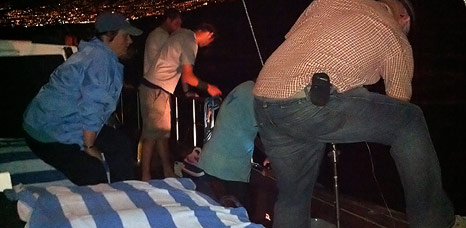I’ve just got back from our ‘Whales & Dolphins of Madeira’ tour, on which we had fantastic weather and cetacean sightings on every trip out to sea, including a group of Atlantic Spotted Dolphins bow-riding, leaping, tail-slapping and generally showing off all around our boat for about 40 minutes in perfect conditions; Short-finned Pilot Whales logging and swimming around us, again in a perfectly calm impossibly blue sea; Loggerhead Turtle, a hammerhead shark and much more. Fantastic!
Squid fishing by Catherine Strong
Naturally, I’ve been talking non-stop about it to everyone - great whale and dolphin sightings, as well as great company, weather and food, lovely hotel ... and then, casually, I mention that we went squid fishing. Interesting to note people’s reactions. Goes a bit quiet for a moment then, after a few polite enquiries about the dolphins, the flurry of questions begins: ‘Squid fishing, eh? So, how DO you catch a squid?’; ‘Do you have to de-ink them?’; ‘Were they tasty?’; ‘Did you get any?’; ‘How big were they?’; ‘Do you catch them with lights?’, and the questions just keep coming.
Well, for all those who were curious, and all those who are curious now, here goes - this is how you catch a squid ...
1. Set off at night in a small vessel with a light on the mast. We set off about 9.30pm from Funchal harbour. It was incredibly atmospheric leaving the marina behind, motoring along under a canopy of stars and with a yellowish moon casting long reflections across the surface of the water.
2. Head for the other boats that are squid fishing - they’re about 8-10 nautical miles out to sea, and you know they’re fishing for squid as they’ve got lights on. (Squid are attracted to the surface by lights.) The idea is that by joining them to form a little group you create more light, and are more likely to catch some. It took us about an hour to reach our squid fishing spot.
3. Look out for bioluminescence & pilot whales. This isn’t an essential of course for catching squid, but it’s impossible not relish being on the ocean at night - and in Madeira the sea floor shelves incredibly steeply to about 500-700 metres even very close to the shore. It’s this underwater topography which attracts the squid and deep diving species of whale such as Sperm Whales and Short-finned Pilot Whales which feed on squid. As we motored along we could see the bioluminescence given off by zoo- and phytoplankton distributed like oversized snowflakes through the sea around us. Then we heard a blow - and the black outline of a pilot whale was clearly visible in the moonlight. Magic. By now we’re all very keen on squid fishing!
4. Light, light & more light - illumination is essential for catching squid. You need as much light as possible really - on your fishing lines, on the boat, on the sea, IN the sea. You get the picture!
5. Try several fishing methods & see which works! Excitement was high as we arrived at our selected spot for squid fishing (chosen by our resident experts, George and Luis). Luis had brought several lines which we lowered into the sea - some with lights on as lures, others with mackerel attached at intervals, and some with nothing but the line.
6. Technique - lower your line down about 4m under the surface and then give sharp tugs continually to attract the squid.
7. Patience - another essential ingredient. Apparently, the squid can appear almost immediately and there can be a sort of frenzy of them around the lines and the boat. However, on our trip, after 2+ hours there was no sign of any squid. You can then either change position and move to another spot, or head home. We were just debating which of these to do when Luis shone the torch into the water one last time and shouted: ‘SQUID!!!’ We all went immediately back into action tugging on our lines ...
8. Stand well back - when the squid are pulled on board the boat they squirt water and ink absolutely everywhere, all around, to a range of about 5m. So you’d be well advised to wear waterproofs or something you don’t mind getting wet and messy (and I can also recommend ducking behind the mast!). And that’s about it - just make sure you store them somewhere they can’t slip out, or put them back, depending on whether you’re going to eat them.
9. Return home & eat them - we arrived back after 2am, happy and well satisfied with our evening’s catch. We caught four squid in total, which Luis’s family ate (curried) the following night - and, apparently, they were delicious!
Any more questions, ask away ...?
To find out more about our 'Dolphins & Whales of Madeira' tour, click here.



 Loading search...
Loading search...
